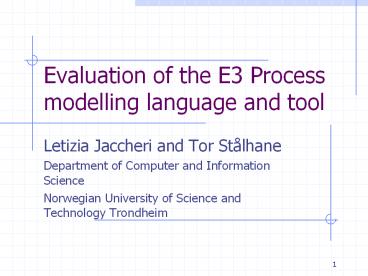Evaluation of the E3 Process modelling language and tool
Title:
Evaluation of the E3 Process modelling language and tool
Description:
Department of Computer and Information Science ... Olivetti. E3 version 1. 1995. Politecnico Sw Eng course. E3 version 1. 1999. NTNU students Ericsson ... –
Number of Views:12
Avg rating:3.0/5.0
Title: Evaluation of the E3 Process modelling language and tool
1
Evaluation of the E3 Process modelling language
and tool
- Letizia Jaccheri and Tor Stålhane
- Department of Computer and Information Science
- Norwegian University of Science and Technology
Trondheim
2
Motivation
- a lot of PMLs and tools have been developed
- few evaluations have been performed
3
This talk
- E3 Environment for Exerimenting and Evolving
software processes - The Experiment
- Problem statement
- Experiment planning
- Experiment operation
- Presentation of the data
- Experiment analysis
- Conclusions
4
E3
1999 NTNU students Ericsson E3 version 2
1992 start
1997 E3 version 2 java Filters and properties
1993 ISPW7 OO Coad Yourdon
1996 Olivetti E3 version 1
1994 Iveco OO Coad Yourdon
1995 Politecnico Sw Eng course E3 version 1
1995 E3 version 1 X C Kernel views
5
Predefined classes and associations
6
E3 p-draw
- Creation of templates by interconnecting classes
and associations - Creation of instance process models
- automatic instantiation
- extension of objects and links
7
Filters
- Workspaces drawing canvas place and modify
- filters to workspaces to hide and show the
entities of interest - inheritance
- derived
- Simple.
- Composite.
- Recursive composite.
- Customization
8
(No Transcript)
9
(No Transcript)
10
This talk
- E3 Environment for Exerimenting and Evolving
software processes - The Experiment
- Problem statement
- Experiment planning
- Experiment operation
- Presentation of the data
- Experiment analysis
- Conclusions
11
Problem statement
40 students 10 groups PM exercise
12
Planning
- H1 For the purpose of creating software process
models, - the E3 PML is easier to use than a standard
modelling language and tool - the average number of modelling problems ?1 that
students encounter when using E3 (PML and tool)
is less than the average number of modelling
problems they encounter when using IDEF0 ?2 - Null hypothesis H0 ?1 ?2
13
Operation
- Decisions
- Students rather than industry
- Ask the students to list problems rather than
questionaires - Students did not get extra teaching around E3
- Challenge
- Motivating students
14
Problems IDEF0
- What was complicate with the modelling activity
was to decide whether a given influence on a
process should be interpreted as control or input
to the process - We had problems to specify resources to
activities and subactivities precisely. - We have used the general concept resources as we
did not have available more precise concepts. - We found that the constraint that one must have
between 3 and 3 subactivities in a IDEF0 model
limiting in a case in which we wanted to have two
sub-activities.
15
Problems IDEF0 (2)
- Sometimes there can be very many arrows between
the different boxes even if we only have 6 boxes.
Such big quantity of arrows makes the models more
difficult to follow and to manage. - Some activities has many inputs and this makes
the model over-complex. - It is difficult to decompose activities.
- We had problems to distinguish between constrains
and input. - The model soon becomes over-complex, especially
when one has many inputs - and outputs
16
Problems E3
- The problem is the overview. Although with a
rather simple process like this one, it is
difficult to maintain control. - The fact that one must model both horizontal and
vertical relationships in addition to document
flow contributes to this.
17
Presentation of data
IDEF0 0 5 1 0 3
E3 0 0 2 0 0
18
Conclusions
- As a conclusion from our data, we are 90 sure
that there will be less modelling problems when
using E3 PML than when using IDEF0 for the
purpose of creating software process models - Risks
- All the problems are equal
- Normal distribution approximation although we
have few data - Six of ten observation are identical and 0
19
Further work
- We need more data
- Register time
- Register the seriousness of each problem
- Is it at all useful to compare two tools?
organization versus experiment setting - Students for research evaluation
20
(No Transcript)































